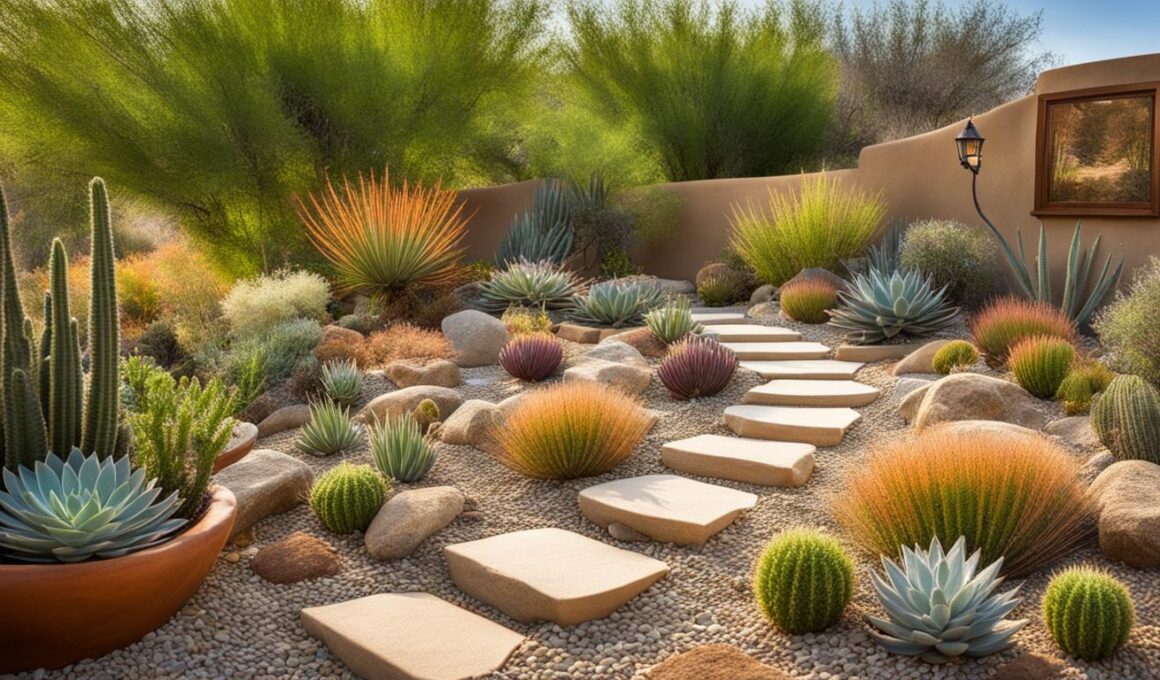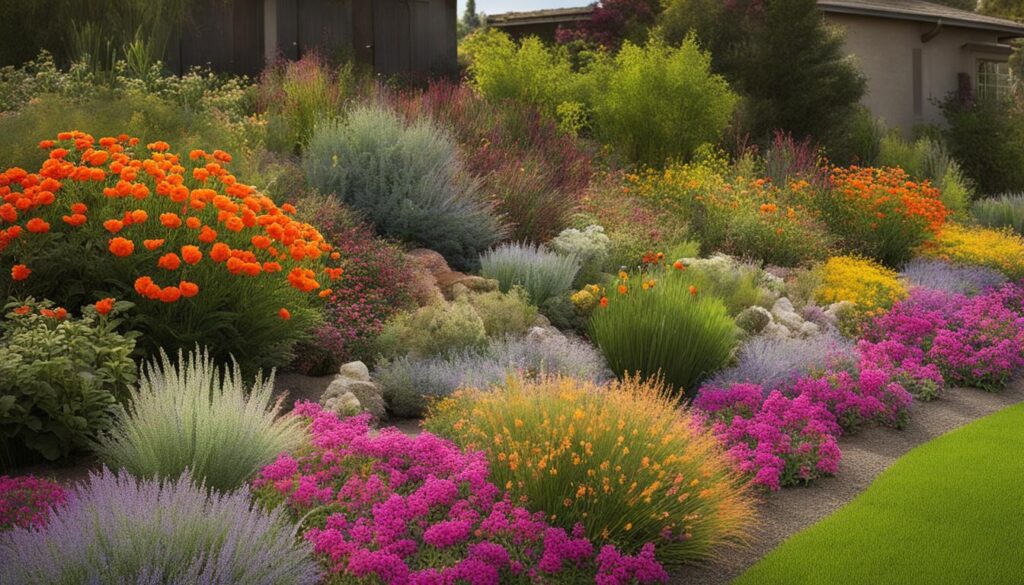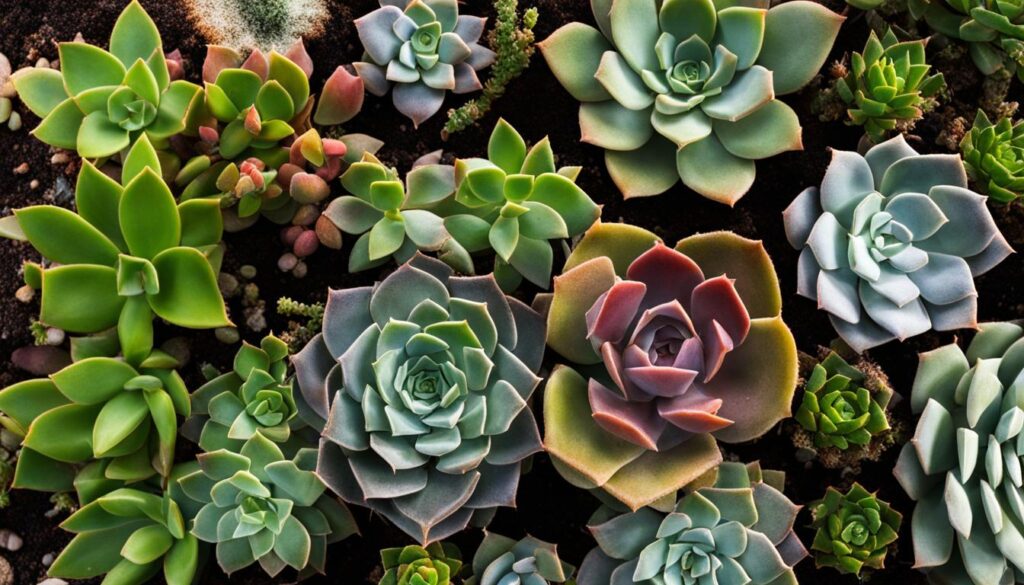Are you looking for a sustainable and environmentally-friendly gardening method that promotes biodiversity and conserves water? Look no further than xeriscape landscaping. By incorporating native plants that are well adapted to your local conditions, xeriscapes can transform your garden into a thriving ecosystem while minimizing the need for fertilizers, pesticides, and excessive watering.
Native plants have deep root systems that help manage rainwater runoff, preventing floods and soil erosion. These plants also attract native species, like pollinators, which play a vital role in maintaining the health and vitality of your garden year after year. With xeriscape landscaping, you can create a beautiful and resilient garden that’s in harmony with nature and contributes to the overall well-being of the environment.
Key Takeaways:
- Xeriscape landscaping incorporates native plants to promote biodiversity and conserve water.
- Native plants have deep root systems that manage rainwater runoff and prevent floods.
- Xeriscapes attract native species, including pollinators, which contribute to the overall health of your garden.
- This environmentally-friendly gardening method reduces the use of fertilizers, pesticides, and excessive watering.
- By embracing xeriscape landscaping, you can create a beautiful and sustainable garden that supports local ecosystems.
What is Xeriscape Landscaping?
Xeriscape landscaping, derived from the Greek word “xeros” meaning “dry,” is a gardening method that focuses on creating beautiful and resilient landscapes with minimal water usage. It involves the use of drought-tolerant plants and water-efficient irrigation systems to reduce water consumption and conserve resources.
By incorporating native grasses, flowers, shrubs, and trees that are well-suited to the local climate, xeriscape landscapes are able to thrive with reduced watering needs. This approach not only saves water, but it also creates vibrant and low-maintenance landscapes that contribute to the overall beauty and health of the garden.
Benefits of Xeriscape Landscaping
Xeriscape landscaping offers a multitude of benefits for both the environment and homeowners. With its focus on water conservation, xeriscapes help reduce water usage for maintaining landscapes by up to 60%. This not only contributes to water conservation efforts but also helps mitigate the potential for water shortages in the future.
Xeriscaping promotes biodiversity by creating habitats that attract pollinators and other native species, supporting local ecosystems. It is also cost-effective, as it reduces water bills and maintenance costs by up to 80%. Moreover, xeriscapes require less maintenance, as native plants are more resilient to pests and diseases, reducing the need for chemical inputs.
How to Create a Xeriscape Landscape
Creating a xeriscape landscape involves several key steps and considerations. It starts with selecting drought-tolerant plants that are well-suited to the local climate and soil conditions. Soil improvements, such as adding compost and organic fertilizers, help enhance soil structure and fertility. Efficient irrigation systems, such as drip irrigation and soaker hoses, deliver water directly to plant roots, minimizing evaporation.
Mulching plays a crucial role in xeriscape landscaping as it helps retain soil moisture, prevent weed growth, and provide insulation for plant roots. Designing a xeriscape landscape can be a creative and rewarding process, with options ranging from gravel and rock gardens to cactus gardens and rain gardens. By carefully selecting the right plants and incorporating design elements that suit the desired aesthetic, homeowners can create beautiful and sustainable xeriscape landscapes.
Benefits of Xeriscape Landscaping
Xeriscape landscaping offers a multitude of benefits for both the environment and homeowners. With its focus on water conservation, xeriscapes help reduce water usage for maintaining landscapes by up to 60%. This not only contributes to water conservation efforts but also helps mitigate the potential for water shortages in the future.
By incorporating drought-tolerant plants, xeriscape landscaping reduces the need for constant watering, allowing plants to thrive even in arid conditions. This results in significant water savings and lower water bills.
“Xeriscaping is an essential strategy for water conservation, especially in regions prone to drought. By minimizing water usage, homeowners can contribute to the overall sustainability of their communities.”
Furthermore, xeriscape landscaping promotes biodiversity by creating habitats that attract pollinators and other native species, supporting local ecosystems. Native plants provide food and shelter for wildlife, helping to maintain a healthy balance in the natural environment.
In addition to the environmental benefits, xeriscapes also offer cost-effectiveness and low maintenance. With reduced water bills and the elimination of the need for excessive fertilizers and pesticides, homeowners can save up to 80% on maintenance costs. Native plants are more resilient to pests and diseases, reducing the need for chemical inputs and making xeriscape landscapes easier to maintain.
Key Benefits:
- Water Conservation: Reduces water usage for maintaining landscapes by up to 60%.
- Biodiversity: Creates habitats that attract pollinators and native species, supporting local ecosystems.
- Cost-effectiveness: Saves up to 80% on water bills and maintenance costs.
- Low Maintenance: Native plants are more resilient to pests and diseases, reducing the need for chemical inputs.
- Environmental Impact: Helps mitigate water shortages and contributes to the overall sustainability of communities.
What Edible Plants Can I Incorporate in Xeriscape Landscaping to Promote Biodiversity?
When it comes to xeriscape gardening, incorporating edible plants for xeriscape gardening can promote biodiversity while also providing a sustainable source of food. Some edible plants suitable for xeriscape landscaping include lavender, rosemary, yarrow, and thyme. These plants not only add beauty to the landscape but also contribute to a healthy ecosystem.
How to Create a Xeriscape Landscape
A xeriscape landscape is a great way to enhance the beauty of your garden while conserving water and promoting biodiversity. Here are some key steps to help you create your own stunning and sustainable xeriscape:
1. Select Drought-Tolerant Plants
Choose native plants that are well-suited to your local climate and soil conditions. These plants are adapted to thrive in your area and require less water once established. Look for drought-tolerant options such as succulents, native grasses, and wildflowers. Incorporating a variety of plants will create visual interest and provide a habitat for different pollinators and wildlife.
2. Improve Your Soil
Prepare your soil by adding compost and organic fertilizers. This will improve soil structure, enhance water retention, and provide essential nutrients for your plants. Well-nourished soil promotes healthy root growth and increases the resilience of your xeriscape landscape during dry periods.
3. Implement Efficient Irrigation Systems
Install water-efficient irrigation systems, such as drip irrigation or soaker hoses, to deliver water directly to the root zone of your plants. This minimizes water loss due to evaporation and ensures that your plants receive the water they need without wasting any. Consider using a timer or moisture sensor to optimize water usage and prevent overwatering.
4. Mulch to Conserve Moisture
Apply a layer of mulch around your plants to help retain soil moisture and suppress weed growth. Organic mulches, such as wood chips or shredded leaves, not only conserve water but also provide insulation for plant roots, keeping them cool during hot weather. Mulching also adds an aesthetic element to your xeriscape landscape, giving it a finished and cohesive look.
“Creating a xeriscape landscape is a rewarding journey that allows you to conserve water, support local ecosystems, and enjoy a beautiful and sustainable garden. With careful planning and implementation, you can create a thriving oasis that is both environmentally-friendly and visually appealing.”
– Gardening Expert
5. Get Creative with Design Ideas
Designing your xeriscape landscape offers endless possibilities. Experiment with different elements such as rock gardens, gravel pathways, or raised beds. Consider incorporating hardscapes and decorative features such as sculptures or water features to add interest to your garden. Don’t be afraid to let your creativity shine and create a unique and personalized xeriscape design that reflects your style and preferences.
By following these steps and embracing xeriscape landscaping principles, you can create a beautiful and sustainable garden that conserves water, supports biodiversity, and adds value to your property. Enjoy the process of transforming your outdoor space into a vibrant and eco-friendly haven.
Conclusion
Xeriscape landscaping is a sustainable and environmentally-conscious gardening method that offers numerous benefits. By incorporating native plants, conserving water, and creating habitats for native species, xeriscapes contribute to the overall health and biodiversity of local ecosystems. It is a cost-effective and low-maintenance solution that saves water, reduces the need for fertilizers and pesticides, and creates visually appealing landscapes.
Whether you’re looking to support local ecosystems, save money on water bills, or simply create a beautiful and sustainable garden, xeriscape landscaping is a smart choice. Embrace xeriscape landscaping and experience the many rewards that come with enhancing your garden’s health and supporting biodiversity.












